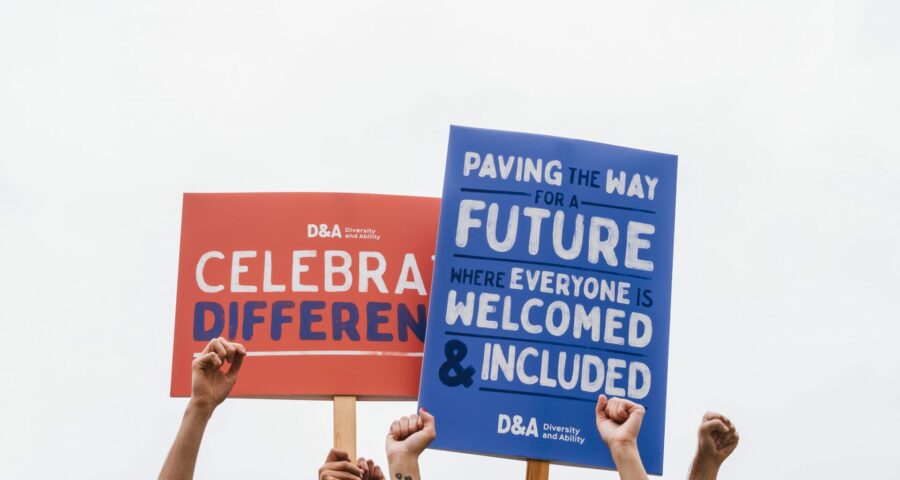Ellie Thompson from Diversity and Ability unpacks how mental ill-health, distress and trauma intersect with disablement.
As a social enterprise led by and for disabled people, we at Diversity and Ability (D&A) are all too familiar with the typical narratives around disablement and mental health. These conversations are so often dominated by othering messages that don’t come from those with lived experience and do very little to encourage authentic inclusion. But, just like NSUN, we’re an organisation that is founded on that lived experience. And we’re advocating for the exact same thing.
Lots of people with experiences of mental ill-health, distress and trauma also identify as disabled. And lots, if not all, of disabled people have experiences of mental ill-health, distress and trauma. Here’s how we know we’re fighting the same fight.
Disability and mental health in multiple ways
A diagnosis of a mental health condition counts as a disability under the Equality Act 2010, the legal framework that protects our rights to access the world and not be discriminated against. But this is about so much more than diagnoses and our current legal rights.
The experience of being disabled brings mental health challenges for so many of us, in so many different ways. For example:
- Disabled people are often more likely to experience domestic abuse.
- The discrimination and exclusion we face, both societally and individually, can be deeply traumatic and distressing, and create lasting mental health challenges.
- Our disabilities may themselves be linked to trauma, such as chronic pain conditions; the experience of being in constant, excruciating pain is a traumatic one and one that has a lasting impact.
Equally, the experience of mental ill-health is a disabling one. In a world that assumes everyone has good mental health- or, at worst, a few ‘bad days’- we’re faced with access barriers that prevent us from participating, including:
- Deeply harmful stigma around mental ill-health, distress, trauma.
- Physical spaces that aren’t accessible due to barriers for those with mental ill-health experiences (for example due to noise levels or crowds).
- Conversations about mental health that focus on diagnosis, and fail to acknowledge the barriers anyone has to work through to access a diagnosis in the first place.
Mental ill-health, distress and/or trauma are disabling experiences
For D&A, we know that the way forward is to dismantle the concept of disabilities and encourage an understanding of disabling attitudes, environments and situations.
Crucially, we’re not ‘people with disabilities’, we’re disabled people; people disabled by a society that only includes one specific type of person, and creates barriers for the rest of us. Thinking about disablement, not disability, also allows us the space to take a fully intersectional approach, because the barriers presented to us aren’t unilaterally presented to people with a medical diagnosis of a mental health condition, chronic illness, learning difference, or anything else that would come under the traditional definition of ‘disability’. The barriers we face, both physical and attitudinal, are complex and multifaceted. They’re presented to disabled people, Black people, non-Black people of colour, LGBTQ+ people, women, older people, and all individuals and communities who experience marginalisation and discrimination. We can’t dismantle disabling barriers without an intersectional understanding of what those barriers are, and how they’re presented to us.
Under this understanding of disablement, all experiences of mental ill-health, distress and trauma are disabling experiences; we are all faced with plenty of barriers that prevent us from accessing and participating in society in the way we’d like to.
Our barriers – and the tools to break them down – are the same
The main tool we have for dismantling the disabling barriers that are presented to us is an acceptance that they exist and that they need dismantling. The conversations we will then have, and tools we can then use, to make society more equitable and accessible for us all? That’s the easy part.
In the meantime, there are tools and resources available that will help us break down the barriers we face. For example, assistive technology can help dismantle so many different barriers, such as communicating with others, focusing, or responding to triggers. What’s more, there are plenty of barriers that can be at least partially dismantled through simple changes in practice; for example, asking people what communication method works best for them, or providing contextual information about spaces and events beforehand. The best thing about these shifts is that they’re available to all, and make spaces better and more comfortable for all of us!
This month is Disability History Month. At D&A, our thoughts about disability awareness events largely echo NSUN CEO Akiko Hart’s impactful reflection on World Mental Health Day. It can be frustrating to see organisations and individuals pay lip service to disability justice for one month while doing nothing to enable genuine change and to witness more exclusion of lived experience happen even throughout a month that should celebrate us. We’ll spend this month the same way we spend every month: advocating for an understanding of disablement that includes everyone, and gives us the tools to break down barriers for good.
About Diversity and Ability
Diversity and Ability is a social enterprise led by and for disabled people. We champion intersectional neurodiversity and disability inclusion, creating positive and lasting culture shifts through bespoke workshops, consultancy and support. We champion intersectional neurodiversity and disability inclusion, providing free resources, guides and toolkits, as well as supporting individuals and organisations to create positive and lasting culture shifts through bespoke workshops, training programmes and consultancy.

